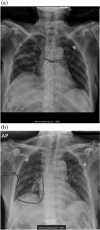Development of a new prognostic model to predict pneumonia outcome using artificial intelligence-based chest radiograph results
- PMID: 38909087
- PMCID: PMC11193777
- DOI: 10.1038/s41598-024-65488-1
Development of a new prognostic model to predict pneumonia outcome using artificial intelligence-based chest radiograph results
Abstract
This study aimed to develop a new simple and effective prognostic model using artificial intelligence (AI)-based chest radiograph (CXR) results to predict the outcomes of pneumonia. Patients aged > 18 years, admitted the treatment of pneumonia between March 2020 and August 2021 were included. We developed prognostic models, including an AI-based consolidation score in addition to the conventional CURB-65 (confusion, urea, respiratory rate, blood pressure, and age ≥ 65) and pneumonia severity index (PSI) for predicting pneumonia outcomes, defined as 30-day mortality during admission. A total of 489 patients, including 310 and 179 patients in training and test sets, were included. In the training set, the AI-based consolidation score on CXR was a significant variable for predicting the outcome (hazard ratio 1.016, 95% confidence interval [CI] 1.001-1.031). The model that combined CURB-65, initial O2 requirement, intubation, and the AI-based consolidation score showed a significantly high C-index of 0.692 (95% CI 0.628-0.757) compared to other models. In the test set, this model also demonstrated a significantly high C-index of 0.726 (95% CI 0.644-0.809) compared to the conventional CURB-65 and PSI (p < 0.001 and 0.017, respectively). Therefore, a new prognostic model incorporating AI-based CXR results along with traditional pneumonia severity score could be a simple and useful tool for predicting pneumonia outcomes in clinical practice.
Keywords: Artificial intelligence; Mortality; Pneumonia; Prognosis; Radiography.
© 2024. The Author(s).
Conflict of interest statement
The authors declare no competing interests.
Figures



Similar articles
-
Chest radiograph-based artificial intelligence predictive model for mortality in community-acquired pneumonia.BMJ Open Respir Res. 2021 Aug;8(1):e001045. doi: 10.1136/bmjresp-2021-001045. BMJ Open Respir Res. 2021. PMID: 34376402 Free PMC article.
-
Predicting mortality among older adults hospitalized for community-acquired pneumonia: an enhanced confusion, urea, respiratory rate and blood pressure score compared with pneumonia severity index.Respirology. 2012 Aug;17(6):969-75. doi: 10.1111/j.1440-1843.2012.02183.x. Respirology. 2012. PMID: 22574694
-
Initial chest radiographs and artificial intelligence (AI) predict clinical outcomes in COVID-19 patients: analysis of 697 Italian patients.Eur Radiol. 2021 Mar;31(3):1770-1779. doi: 10.1007/s00330-020-07269-8. Epub 2020 Sep 18. Eur Radiol. 2021. PMID: 32945968 Free PMC article.
-
External validation of the CURSI criteria (confusion, urea, respiratory rate and shock index) in adults hospitalised for community-acquired pneumonia.BMC Infect Dis. 2014 Jan 22;14:39. doi: 10.1186/1471-2334-14-39. BMC Infect Dis. 2014. PMID: 24447823 Free PMC article.
-
Evaluation of the diagnostic performance of physician lung ultrasound versus chest radiography for pneumonia diagnosis in a peri-urban South African cohort.Pediatr Radiol. 2024 Mar;54(3):413-424. doi: 10.1007/s00247-023-05686-7. Epub 2023 Jun 14. Pediatr Radiol. 2024. PMID: 37311897 Review.
Cited by
-
The evolving reality of digital health.Digit Health. 2024 Sep 26;10:20552076241277646. doi: 10.1177/20552076241277646. eCollection 2024 Jan-Dec. Digit Health. 2024. PMID: 39347511 Free PMC article.
References
-
- Korea, S. Causes of Death Statistics in 2019 https://kostat.go.kr/portal/eng/index.action (2019).
-
- Metlay JP, et al. Diagnosis and treatment of adults with community-acquired pneumonia. An Official Clinical Practice Guideline of the American Thoracic Society and Infectious Diseases Society of America. Am. J. Respir. Crit. care Med. 2019;200:e45–e67. doi: 10.1164/rccm.201908-1581ST. - DOI - PMC - PubMed
MeSH terms
Substances
Grants and funding
LinkOut - more resources
Full Text Sources
Medical

